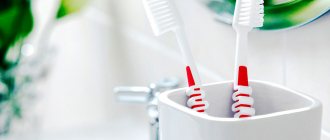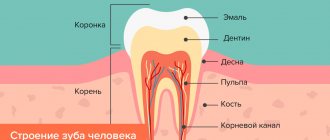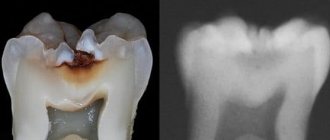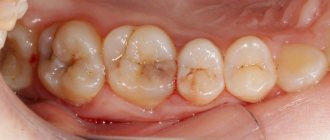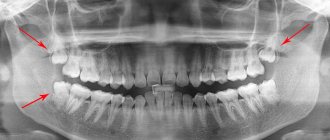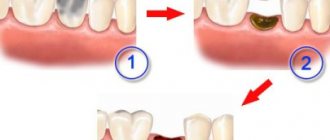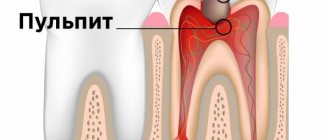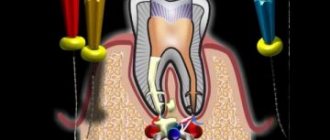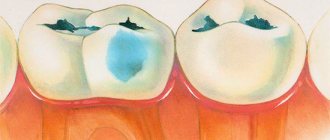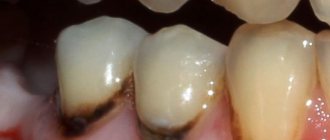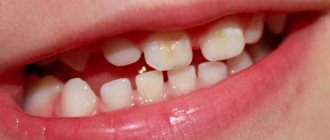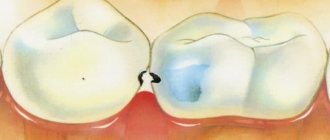1028
Diagnosis of caries is made not only with the help of instrumental or hardware examination. In order to determine the degree of tissue involvement in the pathological process, both before treatment and during the procedure, a caries marker is used.
It allows you to identify affected areas that do not even have visible changes yet.
What does it represent?
A marker for determining caries is a tool designed to accurately determine the area affected by pathology. It is a liquid containing a dye.
The product can be used both to determine caries on the enamel surface and in the area of the prepared tooth cavity .
Operating principle
Due to the special components included in the product, the liquid is retained only on demineralized tissues. Healthy enamel and dentin do not change their color . The marker can be easily removed from their surface not only with water, but also with a regular swab.
How is it different from a caries detector?
Many people also mean a caries detector by a caries marker. But these concepts are different from each other. The caries detector includes various types and types of tools and devices designed to detect caries.
One type of caries detector is a special indicator. This indicator is a caries marker.
What substances are used?
The following substances are mainly used to make markers :
- Propanediol is a natural component obtained from corn sugar. It acts as a solvent for organic compounds found in the pores of the tooth and is responsible for the delivery of the reagent and dye to the deep layers of the affected tissue;
- sodium DDC is an active reagent characterized by high stability, due to which the pigment remains for a long time in dental tissues;
- eosin-B is a red pigment capable of producing coloration at the cellular level;
- distilled water.
Classification of caries detectors and their components
Today, several types of caries detectors are actively used in world dental practice:
- Chemical detectors are precisely those markers whose operating principle is based on the interaction of a brightly colored substance with the surface affected by the carious process.
- Optical detectors that use a light beam with a wavelength of 405 nm to detect pathological changes in the tooth. Based on the degree of refraction in each area of the tooth, a special analyzing program displays different colors on the computer screen, thus forming a visual multi-colored image of the tooth, on which, in the presence of caries, the damaged areas are clearly visible.
- Laser detectors, the principle of operation of which is similar to optical ones, but they use a laser beam as a sensitive element.
It is also useful to read: Features of fissure caries: from diagnosis to treatment
Optical and laser detectors are very convenient in diagnosing caries, but with their help it is more difficult to control the quality and completeness of cleaning damaged areas of the tooth. In addition, they are expensive to purchase and today are the property of only elite clinics.
Caries markers are much more affordable than laser and optical devices, and therefore they are used in most clinics, including fairly budget ones. Their use does not increase the cost of caries treatment, while significantly facilitating the doctor’s work.
Of the active ingredients in caries markers, the most commonly used is acid fuchsin, a well-known synthetic dye that has an intense red color in aqueous solutions. The photo shows how well it stains carious areas of the tooth:
Less commonly, methylene blue is used to detect caries, which works similarly to magenta, but colors the affected areas blue.
Advantages and disadvantages of application
Identification of affected tissues using a marker is used by almost every doctor, since this technique has a number of advantages :
- the ability to accurately distinguish between healthy and infected tooth tissue;
- safety .
This product contains natural ingredients that do not cause discomfort to the patient and do not cause general harm to health. Thanks to this, the marker can be used as a demonstration tool that will allow the patient to clearly see the condition of his dentition; - the liquid can be used not only to identify affected tissues on the surface, but also in the channels ;
- This tool supports the use of invasive type techniques .
Read how to cure cervical caries in a new magazine publication.
This material is devoted to the topic of performing an operation to remove an impacted tooth.
Following the link, we will talk about why a tooth hurts after treatment of deep caries.
In addition to the advantages, this method also has disadvantages :
- the liquid stains all demineralized dentin , even those in which the degree of damage is minimal and allows tissue restoration through the influence of remineralizing agents. As a rule, during preparation they are simply ground off;
- When grinding stained tissues with a bur, a smeared layer of color is often formed, which makes it difficult to visualize the prepared area and highlight healthy tissues.
How to use?
The quality of tooth treatment will depend directly on the treatment with the indicator. In order to avoid mistakes, it is necessary to use this product strictly in accordance with the instructions and, at the same time, take into account all the features of this process.
Instructions
Since all markers contain the same active components, the instructions, regardless of the manufacturer, will be the same for everyone :
- Before application, the patient's teeth are washed with a stream of water supplied under pressure.
- After this, the enamel must be completely dried .
For drying, a warm air flow is used, which forms a special apparatus. Warm air will remove any remaining liquid from the pores and allow them to expand slightly. The more detailed the drying, the brighter the color of the affected tissue. Remaining water will prevent pigment from entering the pores. - An indicator is applied to the dried enamel .
Application is made directly from a dropper or syringe, or using a swab formed from foam rubber. Thanks to its liquid consistency, the marker is evenly distributed over the entire surface. - After 7 seconds, the drug is washed off with a stream of water, and then the surface is dried again.
- The stained tooth tissue is removed using a dental bur.
- After the manipulations, the marker is used again . The procedure is carried out in exactly the same way as described above. Preparation is carried out until the dental tissues are stained.
To enhance the staining effect during preparation, it is necessary to periodically expose the area to short periods of warm air. The absence of a colored surface after applying the marker indicates that all affected enamel and dentin have been removed.
Is it suitable for home use?
Caries markers are intended only for professional use in a dental clinic . Application at home is an impractical procedure, since the product for an inexperienced user will only help determine the approximate area of caries development.
During professional use, an experienced dentist always takes into account the intensity of coloring of different areas, determining the degree of damage to the enamel and its areas that require conventional restorative therapy.
Features and Recommendations
The unique properties of the pigment to stain tissue at the cellular level make it possible to identify not only weakly demineralized tissue, but also completely necrotic dentin located deep in the tooth cavity.
In most cases, incomplete cleansing of dead dentin leads to the development of secondary caries developing under the filling.
In order to ensure high-quality removal of infected tissue, it is necessary to apply a marker repeatedly, followed by detailed preparation. The optimal time for this procedure is from 30 to 60 minutes.
The maximum time will be spent in the treatment of deep caries. The application time should be at least 5 seconds, since in a shorter period the liquid simply will not penetrate all layers of dental tissue.
Can it be used at home?
Markers are intended for professional use in a dental office only. Using them independently at home is not advisable, since inept actions and incorrect application of the product will give the wrong result.
An experienced specialist, when studying colored areas, takes into account the intensity of the color, and from it, with great accuracy, determines the degree of pathology, as well as areas that can be restored with classical therapy.
We invite you to familiarize yourself with Miramistin during pregnancy - instructions for use. Can Miramistin be used during pregnancy?
Security measures
Despite the fact that the caries marker is safe for the patient and the doctor, it should be used taking into account all precautions.
We will tell you how caries of baby teeth is treated without a drill in the next review.
In a separate article we will discuss why enamel coating with fluorine-containing varnishes is used.
Here https://www.vash-dentist.ru/lechenie/zubyi/karies/tsementa-kornya.html we will consider which methods are effective in the treatment of root caries.
What should you be wary of?
When using a marker you need to be wary of the following :
- Staining of healthy tooth tissues, which will lead to their removal. Most often, this situation arises due to application of the product for a longer time than prescribed according to the instructions.
- Removing enamel that can be restored with the help of remineralizing agents.
- Propylene glycol, which is part of the indicator, is considered a safe substance.
But it is still capable of causing allergies in the patient if it comes into contact with the oral mucosa. All allergy symptoms usually disappear after rinsing the mouth. - The pigment is distinguished by the intensity of coloring not only in relation to hard tissues, but also to the skin and textiles. If the liquid is not removed from clothing or skin in a timely manner, persistent stains will form that can only be removed in the future only with a solution of acetic acid.
- Opening the pulp chamber, if this is not provided for by treatment. The dentin bordering the pulp has a pink color, which can be misleading and lead to preparation of the border zone.
How to use a caries marker for preparation, watch the video:
How to prevent it?
To prevent the possible problems described above, the dentist must adhere to certain rules :
- Do not treat a large number of teeth with liquid at once.
This directly affects the efficiency of the manipulations performed, and therefore the quality of treatment. While the doctor is washing the first specimens, not only the affected tissues, but also healthy tissues may become stained in the latter ones. - The time of one application should not exceed 10 seconds. Longer use will result in weakly demineralized tissues taking on the same intense coloration as heavily infected dentin.
- To prevent the risk of developing an allergic reaction, it is necessary to conduct an allergy test before the procedure. To do this, the dentist or his assistant applies a small amount of the product to the patient’s wrist or the inner surface of the elbow.
- To avoid staining the patient's clothing, a disposable medical napkin is placed on his chest.
To prevent the formation of red spots on the lips, it is recommended to pre-treat them with a protective agent based on vitamins A and E, or regular petroleum jelly. If pigment gets on the surface of the lips, they will prevent it from penetrating into the deeper layers. - To identify affected tissues in the deep layers of dentin, it is recommended to use an indicator of a different color. This will prevent the possibility of opening the pulp chamber.
Precautions and Recommendations
Even considering the fact that a caries marker is a completely safe product for both the dentist and his patient, it can only be used if special precautions are taken.
When using the solution you should be wary of the following situations:
- Changes in color of healthy tissue that can be removed. A similar situation occurs if the product was on the teeth for more than the maximum time allowed according to the instructions.
- Cleaning enamel that could be restored with remineralizing agents.
- The propylene glycol contained in the marker, although it is an absolutely safe component, in isolated cases can provoke an allergy in the patient. All manifestations of allergies stop immediately after rinsing the mouth with water.
- Some pigments can color not only fabrics, but also skin and even textiles. Therefore, if drops of the product are not removed from clothing or skin immediately, stains that are resistant to bleach will appear.
- Accidental opening of the pulp. It is known that the pulp chamber is pink, and an inexperienced doctor can accidentally dissect it too.
In order to prevent the development of possible problems when cleaning out carious cavities, the specialist must adhere to the following rules in his work:
- You should not use a marker on a large number of teeth (application is carried out one at a time). During the period while the dentist rinses the first units, even healthy tissues may change color in the last elements.
- The permissible time for liquid to remain on one tooth is up to 10 seconds. Longer use results in even slightly demineralized areas becoming as colored as infected areas.
- To exclude the manifestation of allergies, the doctor is required to do an allergy test before the procedure.
- To prevent drops of liquid from getting on the patient’s clothes, a disposable napkin should be placed on his chest.
- To prevent stains from appearing on the lips, they are treated with Vaseline or a special product that must contain vitamins A and E.
- To examine dentin, a marker of a different color should be used to prevent accidental exposure of the pulp.
Price
The cost of these products has a very wide range. If you wish, you can purchase a caries marker for either 100 or 3000 rubles. In this case, the price will depend not so much on the volume as on the manufacturer.
Among all products, indicators from the following companies are in greatest demand :
- Kuraray . A product from a Japanese manufacturer, 6 ml in volume, will cost 2,500 rubles;
- Color test . Produced by Russian. The average market price for a large 20 ml bottle is 100 rubles;
- Voco . A German drug, the purchase of 3 ml of which will cost 1000 rubles;
- "Omega" . The product was made in Russia, which greatly affects the price. You can buy 8 ml for only 200 rubles.
With such different prices, the composition and properties of these products are practically no different. The only difference can be in the addition of gelling agents, which change the consistency of the product.
If you find an error, please select a piece of text and press Ctrl+Enter.
Tags diagnostics caries treatment caries prevention
Did you like the article? stay tuned
Previous article
How to use Lugol for stomatitis?
Next article
Is it possible to cure allergic stomatitis?
